Content [show]
In winter, you really want fresh herbs, fragrant berries, fruits and vegetables. I would like to, but my hand unconsciously puts back the just taken package with Turkish tomatoes and cucumbers ... Just know how much real-life there is ...
And imagine: cucumbers, tomatoes, peppers, and greens in the midst of winter you can grow yourself without leaving your home - on your two or three windowsills! And along the way, create a summer cottage landscape right in your apartment. No, no, no kidding, if you decide today, and tomorrow you go to the store for seeds, then on March 8, the first cucumbers may already appear on your bushes, and the grown bushes of tomatoes, peppers and beans will make your windowsill look summer green and joyful !
And let us convince you that it is interesting, exciting, important, necessary and not difficult at all! We can grow at home cucumbers, tomatoes, sweet and bitter peppers, carrots, beans, garlic, celery, herbs ... oh-oh-oh, how many things!
Well, let's get it in order?
Cucumbers
Growing cucumbers at home is a very tempting idea. Just imagine: you wake up in mid-March, go to the window, pick a couple of young cucumbers from a green bush, and five minutes later there is a healthy vegetable salad on the table ... And what a smell all over the apartment!
If a thought flashed through you now: "Maybe I should try?" - here are some arguments to help you decide:
- Cucumbers grow very quickly: literally 7-9 weeks after planting, you can cut a salad from your greens!
- It is quite possible to grow cucumbers at home not only for a summer resident who has already "eaten a dog" in vegetable growing, but even for an inexperienced city dweller.
- And a control shot: just imagine how delighted your friends, colleagues and neighbors will be with young cucumbers on your windowsill! You will become an object of ah and ah for a long time))
Want to see how it might look? And here's how in this video:
Stop, stop, do not urgently run after the seeds that you have prepared for summer cottages! Everything is in order. First, we carefully read what you need to know and take into account when growing cucumbers at home.
Suitable varieties
Not all cucumber varieties are suitable for indoor cultivation. You need to choose
self-pollinated
hybrids ... It's best if they will
early maturing ... Even better - if they are also
bush ... And then -
shade-tolerant ))
Excellent proven themselves hybrids:
- ‘Marinda F1’
- ‘Onega F1’
- 'Masha F1'
- ‘Connie F1’
- ‘Legend F1’
- 'Claudia F1'
- ‘Tatiana F1’
- ‘Seryozha F1’
Good reviews are also about varieties:
- ‘Gribovchanka’
- 'Debut'
- ‘Zozulya’
- ‘Ragtime’
- 'Babylon'
- 'April'
- 'Flight'
- ‘Boyfriend’
- 'Athlete'
- ‘Kinglet’
- ‘NIIOH-412’
- ‘Cucaracha’
If you are just starting to grow cucumbers at home, choose from these varieties, you will not go wrong.
The necessary conditions
Cucumbers, like any other plant, have their own preferences. They are:
- photophilous, therefore, the eastern or southern side of the apartment (house) is best suited for growing them. If there is not enough light (and most often this is exactly the case), it will be necessary to organize additional lighting with fluorescent lamps.
- thermophilic, they need a temperature above + 20 ° C (at least + 22 ... + 24 ° C during the day).
- hygrophilous, therefore, the soil should always be moist (moderately, not overfilled).
Tomatoes
A red tomato is clearly not a winter or spring vegetable. Therefore, fresh tomatoes from your garden in April and May are an indescribable pleasure (and pride, whatever you say!).
Many do not dare to grow tomatoes in an apartment, fearing that they simply will not succeed. You know, the bushes strewn with red fruits on the windowsill are only at first glance "how difficult it is to be horrified." Anyone can grow tomatoes at home. Almost everyone grows flowers in their apartments, and this process is no less complicated 🙂
If you are eager to try your hand at growing homemade tomatoes, heed the advice of our experienced summer residents.
Suitable varieties
Suitable for a home garden self-pollinated hybrids... Do not mess with tall varieties - you will suffer. Better to chooseundersized (or even dwarf ones). It is also worth sacrificing love for large tomatoes, it is better to plant small-fruited varieties - they ripen faster and easier.
There are a lot of tomato seeds on sale today of those varieties and hybrids that are specially designed for home cultivation:
- ‘Balcony miracle’
- ‘Room surprise’
- ‘Balcony Red F1’
- 'Alaska'
- ‘Betta’
- ‘Pearl red’
- ‘Pearl yellow’
- ‘Bonsai’
- ‘Japanese room’
- ‘News of Canada’
They enjoy special love
dwarf:
- ‘Minibel’
- 'Bonsai micro F1'
- ‘Pinocchio’
- ‘Florida petite’
- ‘Cherry Pygmy’
- ‘Lisa F1’
- 'Greenfinch F1'
Ampel varieties that look great in hanging pots are wonderful - such as:
- ‘Cherry’
- ‘Talisma’
- ‘Yellow pear’
- ‘Peruvian home’
- ‘Ildi’
Advice
: The store will offer you quite a few varieties of tomatoes, assuring that they are great for home growing. Listening to this and believing the seller, you still carefully read what is written on the packaging: the bags we need have special marks “Home garden”, “Harvest series on the window” or “Recommended for pot growing”. Now, if you saw such an inscription - feel free to pay money)
The necessary conditions
Caring for "home" tomatoes is not much different from caring for them in the country or in a personal plot.
- Tomatoes - plants light-loving, therefore, it is advisable for them to choose the south, southeast or east side. In winter, in an apartment, they need lighting (you can read more about lighting in the article 10 secrets of a home garden).
- They do not like stagnant air, they are afraid damp rooms.
- And here are not afraid of drafts, so feel free to ventilate the room where the tomatoes "live".
- Optimal daytime temperature for growing: before flowering and fruiting - + 22 ... + 25 ° C (night - about + 17 ° C), and then - preferably 2-3 ° C higher.
- Watering, as in the open field, requires rare, but abundant.
Advice:
if you want the tomato bush to be symmetrically developed and beautiful, turn it 180 ° daily in relation to the light from the window - then it will build up the green mass evenly from all sides (some owners turn the pots with bushes by 90 °, considering that there will be even more evenly))
Sweet pepper (bulgarian)
This southern juicy vegetable is quite suitable for "domestication", it is unpretentious, beautiful and very useful.Although you will have to be patient - you will be able to taste the first sweet peppers only 5-6 months after germination.
Growing it at home is interesting, to say the least. Yes, and profitable as well. How is it profitable? Yes, because pepper is a perennial plant, and the bushes planted today will delight you with their harvest for 2-3 years. Tempting? And then! If you decide to add bell peppers to your windowsill, get acquainted with the secrets of growing it.
Suitable varieties
As in the case of cucumbers and tomatoes, for a home garden you need to select early maturing self-pollinated hybrids... In home culture, varieties have proven themselves best. universal purpose, used both for planting in open ground and in protected:
- indoor pepper 'Patio-Ivo', which pleases with its bright yellow fruits at any time of the year on the windowsill or balcony;
- thick-walled peppers of the improved selection ‘California Miracle’ - up to 75 cm high, with beautiful bright red fruits with a ribbed surface;
- medium-early high-yielding hybrid of Dutch selection 'Jupiter F1' with very large fleshy fruits that change color from green to red;
- very sweet pepper of the 'Oda' variety - purple in color, undersized (35-50 cm) and very productive.
Good reviews received medium early varieties:
- 'Martin'
- ‘Bulgarian-79’
- ‘Gift of Moldova’
- ‘Novogoshary’
- 'Winnie the Pooh'
The necessary conditions
Bell pepper will not be "capricious" and will thank you with a good harvest, if you observe several important conditions for it:
- This plant is southern, so it must be placed in the sunniest room, where there is most of the light. If there is not enough light, it will be necessary to artificially illuminate it.
- Sweet pepper is a sissy, he does not like drafts.
- The optimum air temperature for its maintenance is + 20 ... + 26 ° C (at night + 18 ... + 20 ° C).
- Regular soil loosening necessarily.
- Pepper needs pest protection (aphids and spider mites).
- During the fruiting period, pepper is needed tie up to the trellis.
Advice: it is categorically not recommended to grow sweet and bitter peppers on the same windowsill (and in the same room) - as a result of cross-pollination, all your peppers will turn out to be bitter (a distance of 2-3 m to the neighboring windowsill is not an obstacle, you can skip checking))
Bitter pepper
I think that bitter pepper lovers will never give up the opportunity to always have a bush with burning pointed fruits at hand ... because for them any dish with hot pepper becomes immeasurably tastier))
But to grow such a miracle on the windowsill is not difficult at all. To do this, you only need the presence of the sun in the window for 3-4 hours a day, a pot of soil, and the necessary seeds. And in 2-3 months you will have a gorgeous treasured bush, strewn with medium-sized fruits. And it can bear fruit in one place up to 5 years!
By the way, it is especially worth emphasizing that all representatives of "bitter peppers" are highly decorative and will certainly become a decoration of your home garden!
I don't think I had to persuade you)) It remains only to skim through a few lines of the necessary information.
Suitable varieties
For home cultivation, seeds of early-maturing self-pollinated varieties and hybrids are best suited. To the delight of spicy lovers, almost all varieties of hot pepper fully meet their purpose)
These are varieties and hybrids:
- ‘Astrakhansky 147’
- ‘Elephant trunk’
- ‘Ukrainian bitter’
- 'Indian summer'
- ‘Fire’
- ‘The Queen of Spades’
- 'Sweeties'
- ‘Carmen’
- ‘Superchile F1’
- ‘Curiosity’
Special feedback received two varieties of pepper:
- ‘Serpent Gorynych’ is a high-yielding, very spicy burning taste.
- The 'Elephant's trunk' is the largest-fruited of all hot peppers, reaching 27 cm in length.
The necessary conditions
In order for hot pepper bushes to grow and develop without problems, several basic conditions must be met from the very beginning.
- Prepare a quality soil substrate.
- Plants are best placed on south, southeast and southwest windows where most of the world... If there is a lack of lighting in winter, it is imperative to carry out additional lighting.
- To not allow drying out soil.
- Do not pinch, then the bush will be voluminous and "rich".
- During fruiting feedas it tends to be abundant and quickly depletes the soil.
Beans
Everyone can grow beans on the windowsill. Moreover, it is unpretentious, rises and grows quickly, does not require special care. It is a self-pollinating plant; in a month and a half it will bloom, and in two you will be removing young pods. They are extraordinarily tasty in vegetable stews, soups, in an omelette and simply stewed.
Believe me, you will not regret it if you decide to "get" a couple of bean bushes).
Suitable varieties
Practice has shown that it is most profitable to grow at home early maturing varieties of asparagus bush beans... But also curly varieties shouldn't be written off. At the very least, they are very decorative - long bright green vines with large flowers of pink, purple or white look amazing. And you won't be left without a crop either.
Which beans to choose?
- has proven itself well black Eyed Peas ‘Fatima’.
- good reviews of summer residents received varieties bush beans ‘Triumph Sugar 764’, ‘Sachs Without Fiber 615’, ‘Mask’ and ‘Green Pod 517’.
- from curly beans it is recommended to choose either ‘Golden Neck’ or ‘Violetta’.
The necessary conditions
It is easy to take care of the beans, it is enough to provide them with regular watering, loosening and feeding and fulfill a few simple requirements:
- The container for growing bush varieties should be at least 2 liters in volume, and for climbing varieties - 30-35 liters.
- Bush beans more photophilous, it is best placed on the windows of the south and southeast side, curly can "live" on either side. Beans, as a rule, do not need additional lighting.
- Curly beans need ropes (wire, mesh) to supports.
- The yield of beans is increased feeding superphosphate and potassium chloride.
Carrot
Have you ever heard that carrots are grown on a windowsill? In a simple flowerpot or container, you can get a very decent harvest. Most varieties will allow you to start picking fresh carrots as early as 3.5 months after planting: when the majority of summer residents just start sowing carrots, you will already be eating them!
Carrots, of course, are capricious, but the main thing is to know a few secrets, and then you will "make friends" with it for a long time:
Suitable varieties
Carrots are remarkable in that the root crop, even when it has just been born, is already suitable for consumption. Therefore, growing it is a win-win business))
- For growing at home, it is best suited mini carrot of the Parisian Carotel variety - these are the ‘Parmex’, ‘Sophie’, ‘Grandfather’ varieties. It grows in 80-90 days and does not require much space - a pot or container is fine.
- You can also opt for early maturity sort ‘Amsterdam’.
- And kids will love the round little 'Round Baby' roots.
The necessary conditions
You need to start with preparation lightweight and well-drained soil. This is extremely important: the easier it is to penetrate oxygen into the soil, the juicier and healthier the roots will be.
- Tank depth (container, pot, flowerpot) must be large enough for the roots to develop normally.
- Temperature the environment must be kept within the range of + 13… + 24 ° C.
- Carrot does not like direct sunlight.
- Watering requires regular (more often than in the open field). In this case, the presence of drainage holes is mandatory!
- To retain moisture in the soil, you need to carry out mulching.
- Do not get carried away nitrogen fertilizers, you risk getting a lot of tops, not carrots.
Advice
: Carrots can be grown in cut plastic bottles. And cheap, and convenient, and mobile))
Home garden with herbs
Well, what a vegetable garden without greenery? Onions, parsley, dill, salads, basil, mint ...
If you are a fan of greenery on the window, we advise you to read the articles on our website:
- 5 types of greenery that are easy to grow on a windowsill
- Growing green onions in a plastic bottle
- How to grow parsley on a windowsill
- How to grow delicious onions on a windowsill - secrets and subtleties
- How to quickly and easily grow watercress on a windowsill
- 10 secrets of the home garden
And finally, we suggest admiring the home garden of Nadezhda Shcherbinina. Any of us can make the same branch of a summer residence ... you just want to.
The more snow outside the window, the whiter the landscapes, the more we miss the bright colors of the past summer, the fresh biting sound of a jet from a hose, the whisper of herbs - at our dacha. Hands have long missed the ground, and oh, how long to beloved beds ...
But it is in our power to reclaim a piece of summer and a summer residence. There is everything for this - desire and ... a window sill! Let me remind myself once again: if we start right now, then by March 8 we may already have our own cucumbers! Let's start?
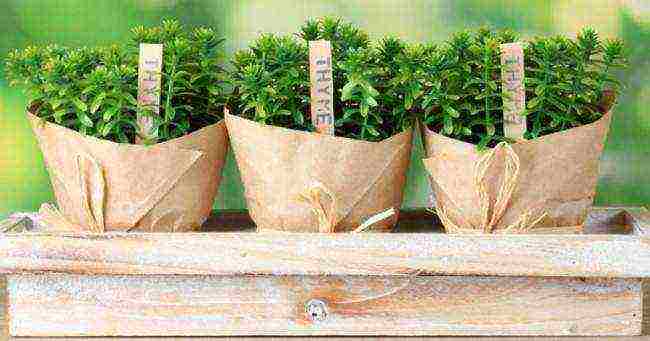

Sometimes I want to go out onto the balcony, like Jamie Oliver, pick up my own grown vegetables and herbs and stir something stunning out of them. And the balcony, by the way, looks much nicer if it does not store old pieces of iron that it is time to send to the landfill, but aromatic herbs and vegetables.
I chose several interesting plants that take root well on the windowsill or on the balcony.
Pepper
On the windowsill, you can grow a hot pepper for diablo pizza. It will require a warm, bright place and varieties suitable for home cultivation: "Carmen", "Flint", "Ogonyok", "Ryabinushka", "Bride", "Indian Summer", etc.
The bushes are very cute and do not require large pots. Up to 50 fruits can be set on one plant. The optimum temperature is 25-27 degrees Celsius.
Carrot
For growing carrots at home, it is better to take mini-varieties such as "Parmex", "Sophie", "Vnuchka". They grow in 80-90 days and do not require a lot of space - they are quite satisfied with a pot or container. You can also take a funny round variety "Round baby".
The soil for the carrots should be light and well-drained. The vegetable can be grown in cut plastic bottles. The optimum temperature is in the range of 13-24 degrees Celsius.
Mint
Mint is a non-capricious and undemanding plant. It can grow on your windowsill or balcony, even in winter, if you arrange additional lighting. It can be grown from cuttings and seeds. If there is an opportunity to dig up a stalk in the country at home or from friends, it is better to use this method. Mint, grown from seeds, is not taken as actively, and it will take longer to wait for the harvest.
It is important to remember that the plant loves well-moisturized soil. And, when choosing a place for it, keep in mind that the lighting should be good, but it is better to avoid direct sunlight. The optimum temperature for mint is 20-25 degrees with a plus sign.
Green onions
Growing green onions at home does not require any special dexterity. But nevertheless, it is worth considering some nuances: the bulb that you will plant should be round, dense to the touch and free from rotting marks, the root cup should be well-formed.
Immediately after planting, it is worth putting the onion in a cool, dark place so that the root system is better formed, and only then the feather will need a lot of light. The optimum temperature is 18-20 degrees, you should not overheat, because then the growth of greenery will stop.
Basil
Any kind of basil grows well in flower pots and boxes. It is better for him to allocate a sunny place, water well, keep warm and provide good drainage. For planting, you can use both cuttings and seeds.At the same time, the cuttings will quickly give the first harvest, but they will not last long, since they will bloom quickly. You will have to wait longer to harvest from seeds, but such a bush will also last longer.
The optimum temperature for basil is 20-25 degrees Celsius. In winter, backlighting is required for about 3-4 hours to increase daylight hours.
Cucumbers
To grow cucumbers on a windowsill or on a balcony, you should take a closer look at the hybrid varieties that are marked with the F1 icon. If all conditions are created for a plant, it can give 3-4 dozen fruits. Here you will have to tinker a little with the seedlings, but after transplanting into boxes, you will only need to water and cut the antennae.
Plants are planted in containers with a volume of at least 5 liters. It is important to remember that cucumbers are large water loaves and the ground should always be moist. The optimum temperature is 21-24 degrees Celsius.
Tomatoes
Dwarf varieties are usually chosen as home-grown tomatoes: Minibel, Florida Petit, Balcony Miracle, etc. You will have to take the most illuminated place in the apartment for this miracle. You will need to start with seedlings, then plant them in containers, tie them up, feed them and protect them from the cold. This is one of the most troublesome balcony crops, but pride in the work done and gardening talent is attached to the crop.
It is important to remember that tomatoes, like all plants, love water, but they can be easily poured over. Therefore, water should be done carefully. The optimum temperature is 23-25 degrees Celsius.
Sorrel
Sorrel, in addition to its wonderful taste, is distinguished by the fact that it calmly tolerates shaded places. It can be grown from rhizomes of 2-4-year-old plants with buds or from seeds of such varieties as "Maikop", "Altai", "Odessa broadleaf".
It can grow at 5 and 20 degrees Celsius and even withstands small frosts. So on the balcony it can be kept until the last, and if the balcony keeps heat well, then it should not be cleaned for the winter. The leaves are cut at a height of 8-10 cm, this must be done carefully so as not to damage the growth buds.
Ginger
Ginger is not only a delicious seasoning, but also a beautiful plant. If you plant it at home, the shoots can grow up to a meter in height. Pieces of ginger root are planted, consisting of at least a couple of sections with live buds. If the root is dry, you can hold it in warm water for several hours to wake up the kidneys.
The root should not be planted very deeply, and until the first shoots appear, it should be watered very sparingly. Keep ginger in the light, but away from direct sunlight. The optimum temperature is 20-25 degrees Celsius.
A pineapple
To grow pineapple at home, you need to be patient and find a suitable fruit - purchased in the warm season and with an intact tail. The tail is cut with a knife, preferably without pulp, dried for 3-4 days in the light, and then germinated in clean river sand. When the roots appear, after about a month, it can be transplanted into a pot of soil.
Pineapple loves light, warmth and spraying. The fruit will appear about 2 years after planting. The optimum temperature is 23-30 degrees Celsius.
Strawberry
Strawberries can be grown at home all year round, in winter you will need to arrange lighting. To do this, you should choose remontant strawberry varieties that bear fruit more than once a season, but constantly, for example: "Yellow Miracle", "Queen Elizabeth", "Mount Everest". You can grow strawberries from seeds, but the easiest way is to buy ready-made seedlings. After 3-4 months, a couple of bushes will give new rosettes, and your plantation will increase by 3 times. Meanwhile, as with the germination of seeds, you will have to tinker.
Strawberries are afraid of the cold, so they should be taken out to the balcony only when the weather is warm. The optimum temperature is 18-24 degrees Celsius. It is important to remember that since there are no insects at home, you will have to pollinate the flowers yourself with a brush.
Thyme
Thyme is a wonderful herb. It is very fragrant, tasty and extremely unpretentious.Thyme naturally grows in dry areas with poor soil. Therefore, ruining it at home is not easy. The most important thing he loves is light. It is not afraid of direct sunlight, and it can be placed even where other plants will die. The only difficulty is watering: in the sun, the soil in a small volume of the pot dries quickly, and the thyme itself does not like waterlogging.
It also makes no sense to overdo it with fertilizers - thyme will not appreciate it. It can be grown both from cuttings and seeds.
What goodies grow in your home?
Cucumbers, peppers, carrots and even strawberries! All this can be grown on a balcony or windowsill and there is fresh, eco-friendly, and most importantly, free vegetables and fruits all year round. Right now, we will tell you how to set up a mini-vegetable garden in a city apartment.
Growing food in a city is popular all over the world. So, Britta Riley lives in a tiny apartment in New York. She came up with a vertical hydroponic vegetable garden. It takes up little space and produces a good harvest. Britta talked about her innovation at TED.
In the West, if a product is labeled eco, bio or organic, it means two things. Firstly, these products are grown, harvested and processed in accordance with environmental standards, that is, without pesticides, synthetic fertilizers, growth stimulants and other "nasty". They have been certified, and serious organizations have guaranteed their quality. Secondly, organic products are much more expensive than conventional ones.
In Russia, the “clean food” market is just emerging. Biocertification and control systems have not yet been formed. And the difference in prices between organic products and ordinary vegetables and fruits sometimes reaches 1,000%! Therefore, for us, the most eco, bio and organic are products grown by our own hands.
But not everyone has dachas and relatives in the village. What should urban children do, who are accustomed to seeing potatoes washed and in nets, and greens in vacuum packages? Grow vegetables and fruits directly on the balcony or windowsill.
6 reasons to arrange a mini-vegetable garden at home
- You can pamper yourself with fresh vegetables and herbs full of vitamins all year round.
- Saving. Vegetables and fruits are expensive, especially in winter. With a home garden, you no longer have to adjust to the season (we eat plenty of tomatoes only in July, and apples in September).
- You yourself can grow a plant from a tiny seed with your own hands, you can collect fruits. This is a creative activity that charges with positive energy.
- You can improve your knowledge of biology, gain useful skills and acquire an exciting hobby.
- Your children will see how tomatoes, cucumbers and other vegetables grow, and they will understand that they do not materialize miraculously in the refrigerator, their cultivation is a serious work.
- You can surprise your friends and acquaintances. Imagine showing off your harvest by showing your window beds. 😉
What you need to grow vegetables and herbs at home
- A place... This is usually a windowsill or balcony. Better if they face the sunny side. If not, lamps will be required for additional lighting. If necessary, the window sill can be expanded or racks for "beds" can be built (the minimum distance between shelves is 50 cm).
- Containers... Clay or plastic pots, wooden boxes can serve as beds for a home garden. The main thing is that there are holes in the bottom for draining water. It is recommended to place containers on pallets.
- Priming... There are many potting mixes available for indoor gardens. As a rule, several layers are made: peat, compost, turf. You can prepare the soil yourself, or you can buy it in a specialized store.
- Seeds... Some varieties of tomatoes or cucumbers grow well at home, while others do not even sprout. Therefore, before you start indoor gardening, you need to sit on the forums, read articles on the Internet and find out which seeds to buy.
In addition, you may need fertilizers, top dressing, a thermometer and a vessel for settling water (house plants are watered with water at room temperature, separated from chlorine).
We have the inventory, now we need to decide what to plant. The life hacker has already written about some vegetables that grow well on the windowsill.
16 foods you can grow at home
Today we will tell you about ten more such plants.
Carrot

Variety: "Amsterdam".
Temperature: from 15 to 25 ºС.
Harvest: in ≈70 days.
For growing at home, you need to take miniature carrots. You can plant in boxes, pots or just cut plastic bottles with holes in the bottom. Drainage soil should be taken.
The seeds are placed in the ground to a depth of about 7 cm. When the carrots have sprouted and germinated a few centimeters, they must be thinned out, leaving the strongest shoots at a distance of about 2 cm from each other. It is not recommended to keep the beds in direct sunlight.
You need to water the carrots at home often, but you need to make sure that there is not too much moisture, otherwise the root crop will rot. From time to time, you can feed with fertilizers with a low nitrogen content (if there is a lot of it, all the growth will go to the tops). It is also very useful to loosen the soil sometimes.
Pepper
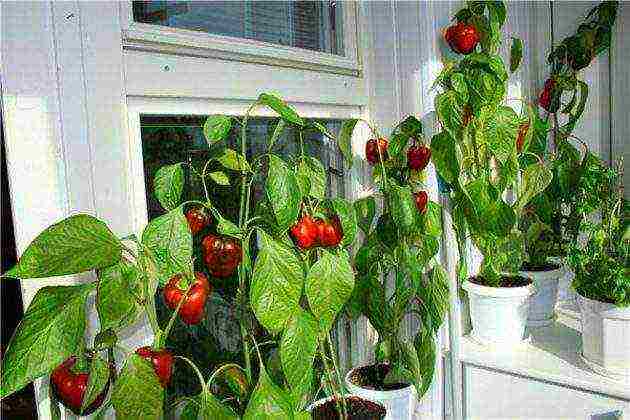 Balcony-Grown Peppers
Balcony-Grown Peppers
Varieties: "Treasure island", "dwarf", "watercolor", "swallow" and others.
Temperature: from 25 to 27 ºС.
Harvest: after 100-130 days.
For growing peppers in an apartment, it is recommended to use a special soil enriched with trace elements. It is sold in gardening shops. The primer can be supplemented with hydrogels for greater friability.
The seeds are first planted in small pots, which are covered with cling film and placed in a warm place. When the first shoots appear (after one to two weeks), several small punctures need to be made in the film. After a while, the pepper will get stronger, then it can be transplanted into large pots or buckets. This must be done carefully so as not to damage the spine. The plant is rooted by a third, after which it is watered with warm (30 ºС) water.
In the future, the pepper can be watered every day. This plant loves light, so white light bulbs are recommended in addition to natural light. It is necessary to protect home-grown peppers from drafts and direct sunlight.
You can fertilize with nitrogen fertilizers, but potassium salt and potassium chloride will destroy the roots of the plant. With proper care, peppers on the windowsill can delight with fruits up to two years.
Cherry tomatoes

Varieties: "Pygmy", "bonsai", "bead" and others.
Temperature: from 23 to 25 ºС.
Harvest: after 90-100 days (depending on the variety).
The soil, as in the case of pepper, is more convenient to buy ready-made. It is recommended to take a cylindrical container: it is better filled with the root system.
First, the seeds are germinated in small pots: they are buried to a depth of 1.5 cm, covered with cling film and left in a warm place until the first shoots. When the tomatoes have risen, they are dived into a larger and deeper dish.
It is important that the plant receives uniform lighting. To do this, over the "beds" you can hang fluorescent lamps or regularly turn the containers to the window.
Watering should be done carefully: cherry is easy to pour. When the plant grows, it is recommended to loosen the soil from time to time and feed it with mineral fertilizers. If necessary, the stem of the tomato can be tied to a support (wooden skewer or pencil). It is also important to ensure that pests do not appear on the tomatoes.
By the way, not only cherry tomatoes grow well in home gardens, but also ordinary tomatoes.
Cucumbers
 Cucumbers grown on the window
Cucumbers grown on the window
Varieties: "Rytov's room", "miracle on the window", "ant" and others.
Temperature: from 21 to 24 ºС.
Harvest: after 35–45 days.
For cucumbers, rather large containers are needed, with a volume of at least 6 liters. The soil should be loose, with peat or compost.
Self-pollinating cucumber varieties grow well at home. First you need to prepare the seeds: they are poured into a weak saline solution, those that have surfaced are thrown away. Then, suitable seeds are soaked for 20 minutes in a solution of potassium permanganate, after which they are washed on damp gauze and planted in the ground (under a film). When the seedlings sprout and grow, they can be planted in large containers.
Home cucumbers are poured with warm water every day, but with caution. Leaves can also be sprayed with a spray bottle. Potassium nitrate is recommended as a top dressing.
When the cucumber lashes form and grow, props should be built for them so that the plant can weave.
Radish
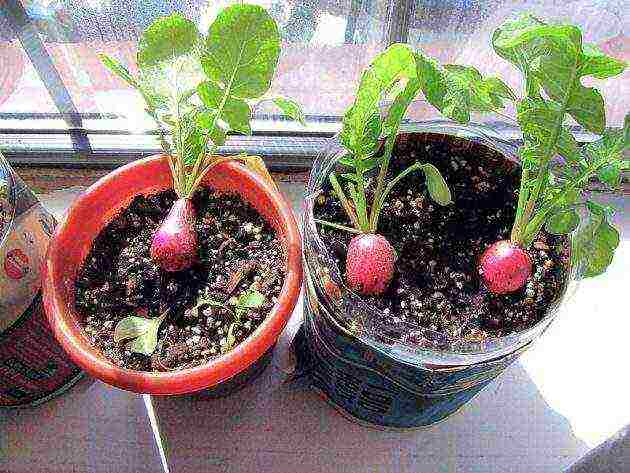 Homegrown radish
Homegrown radish
Varieties: "Carmen", "white fang", "celeste F1" and others.
Temperature: from 18 to 20 ºС.
Harvest: after ≈40 days.
It is recommended to plant radishes in wooden or clay containers, but ordinary plastic cups can also be used. You need a loose, well-drained soil. Seeds can be tested for germination before planting, like cucumbers. Then they need to be buried to a depth of 1-3 cm.
After planting, the soil must be watered and covered with foil. When shoots appear, the "greenhouse" is removed. Radishes are generally not dived. But sometimes it is placed for two or three days in a lower temperature regime - about 15 ° C. This hardens the plant and promotes a better harvest.
Five days after the appearance of the first shoots, organic feeding is carried out, and two weeks later - mineral. Water the radish abundantly as it dries. It is also important that the air in the room where it grows is not dry.
Spinach
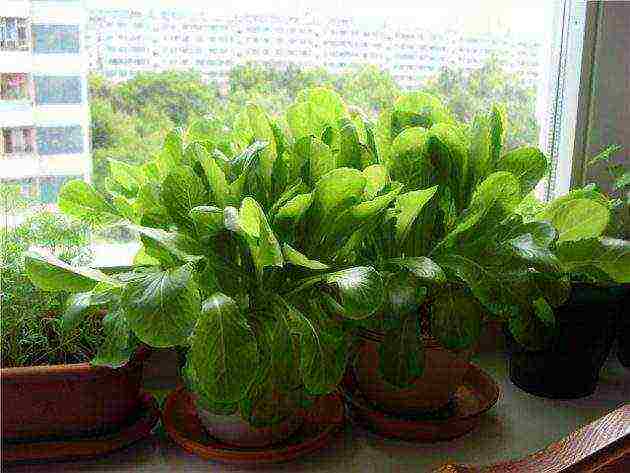 Homemade spinach
Homemade spinach
Varieties: "Virofle", "godry", "gigantic" and others.
Temperature: 15 ºС.
Harvest: after ≈40 days.
Spinach is a green vegetable and is considered very healthy. To grow it at home, you need containers 15–20 cm high. You can use ready-made potting mixes. The main thing is that they include peat.
It is recommended to soak the seeds in water for a day before planting. Sowing is carried out to a depth of 1–2 cm. To accelerate germination, you can cover the containers with foil. Spinach emerges about a week after planting, then it can be dived.
In winter, when the apartment is heated and when there is a short daylight hours, it is recommended to illuminate the plant with lamps and spray from a spray bottle (in addition to watering).
You can harvest when the spinach is 7-10 cm tall.
Basil

Varieties: "Marquis", "lemon", "Baku" and others.
Temperature: from 22 to 24 ° C.
Harvest: after 50–55 days.
Basil is one of the most aromatic and favorite seasonings of housewives. At the same time, it is quite unpretentious and grows well on the windowsill.
Basil is planted immediately in large containers (with a volume of at least 1.5 liters). First you need to prepare the soil for planting: water it twice with mineral fertilizers at intervals of five days. The seeds are deepened by 1–1.5 cm. Until the plant sprouts, it must be watered every two days. Further watering is carried out daily, preferably in the morning.
Basil loves the sun. Therefore, it is recommended to extend the period of insolation up to 15-17 hours a day using fluorescent lamps. Also, once every two weeks, you can loosen the soil to enrich it with oxygen.
Green garlic

Varieties: "Kharkiv", "Jubilee" and others.
Temperature: from 18 to 25 ° C.
Harvest: after 15–20 days.
Typically, garlic bulbs are used in cooking. But green shoots (arrows) are also suitable for gastronomy: they are suitable for making marinades and sauces.
Garlic varieties are divided into two groups: winter and spring. The latter usually do not produce arrows, so they are not suitable for growing at home.
For those who have ever grown onions on a windowsill, garlic will not be difficult to cope with. You need to take cloves of winter garlic, preferably with sprouted sprouts. You can take any soil mixture.Each clove is planted at a depth of 2-3 cm and at a distance of 1-2 cm from each other. After planting, be sure to water.
The container with garlic should be kept on the lightest window in the house. Water as the soil dries up. From time to time, you can feed with nitrogen-containing fertilizers.
Mint
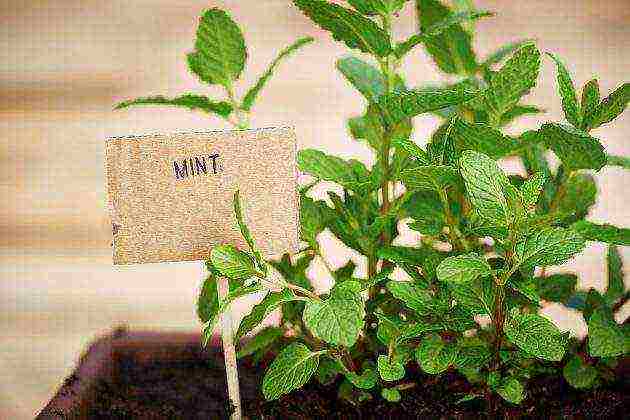
Temperature: from 20 to 25 ° C.
Harvest: after ≈60 days.
Mint has a rather branched root system, so you should take a deep and wide container for planting it. It is recommended to use peat soil, any varieties.
There are two ways to plant mint: seeds and cuttings. The latter is shown in the video below.
To grow mint from seeds, you need to plant them in the ground to a depth of about 5 mm and water. To create a greenhouse effect, you can use a film. Before germination (after about two weeks), the soil should be sprayed with water every day. After germination, the mint must be planted.
Mint is unpretentious. In summer, it must be protected from direct sunlight, and in winter from lack of light and excessive watering. From time to time, the plant can be fed with organic mixtures.
Mature plants can be up to a meter in height. As a rule, they have a lot of leaves - there will be mint for tea or homemade mojito almost always.
Strawberry

Varieties: "Autumn fun", "home delicacy", "garland" and others.
Temperature: from 18 to 20 ° C.
Harvest: in ≈30 days.
For a home garden, ampelous remontant varieties of strawberries are suitable. They bear fruit all year round and are not too demanding on light. You can plant strawberries in any soil mixture. But first, drainage (expanded clay, small pebbles) should be poured onto the bottom to protect strawberries from stagnant water.
Strawberries can be grown from seedlings or seeds. Both are sold in shops for gardeners.
The seeds are planted in small containers (for example, plastic glasses), watered abundantly and covered with cling film. After the first shoots appear, the film is removed and the seedlings are placed in a well-lit place. When three to four leaves are formed, the strawberries are dived into larger containers.
This plant loves light. When days are shorter than nights, artificial lighting should be used. Watering and spraying is carried out as the soil dries up. Strawberries are easy to pour.
As a top dressing, solutions with a significant iron content are used. During active growth, strawberries grow overgrown with mustaches, they need to be tied to supports.
As you can see, growing vegetables, herbs and even berries in a city apartment is not difficult and even exciting.
If you have experience in home gardening, tell us about it. Write in the comments, what and how did you happen to grow on your windowsill.
 Vegetables are an irreplaceable low-calorie dietary product in the diet, which, if consumed regularly, has a positive effect on human health. From this article we will learn how to grow vegetables with our own hands in an apartment, we will get acquainted with the nuances of agricultural technology for growing tomatoes, cucumbers and peppers on the windowsill.
Vegetables are an irreplaceable low-calorie dietary product in the diet, which, if consumed regularly, has a positive effect on human health. From this article we will learn how to grow vegetables with our own hands in an apartment, we will get acquainted with the nuances of agricultural technology for growing tomatoes, cucumbers and peppers on the windowsill.
The main natural source of vitamins that humans need are vegetables. Therefore, they are widely used in the preparation of salads and other dishes. Vegetables strengthen the body's defenses and its resistance to various harmful environmental influences. This protection is especially important in the autumn-winter period, when the body can be exposed to influenza and other respiratory viral infections.
To provide yourself and your family with the necessary vitamins in winter, vegetables can be grown at home on a windowsill or in a heated loggia. For this, there are specially invented agricultural techniques, which we will now familiarize ourselves with in detail.
Correct organization of the garden on the windowsill

You can grow vegetables on the windowsill all year round, which is not at all difficult with proper preliminary preparation.
If you have a narrow sill, you need to expand it in two ways:
- You can take a sheet of plywood 7-10 mm thick and 20 cm wide, corresponding to the length of the window sill, slip it under the window frame with one side and fix it, thus increasing the area of the window sill.
- You can also increase the area with the help of stools, which can be placed near the windowsill and put a board 20 cm wide on them, and put containers with seedlings on top of it. The top of the crockery with the plants should be on a level with the windowsill so that the plants are light and warm.
Any containers are suitable for growing vegetables, the main thing is that the plants are not cramped in them. You can use ceramic vases, or you can use cut 5-6 liter water bottles. You can also make wooden boxes from spruce or pine boards, taking into account the required volume for each plant. Drainage must be poured at the bottom of the containers to prevent stagnation of water and decay of plant roots. You can read more about this in the article "Growing greens on the windowsill".
For growing vegetables, you can use a ready-made soil mixture, which is sold in specialized stores, or you can cook it yourself. To do this, you need to observe the following proportions: 80% of the land from the garden, 10% humus, 10% sand. Before planting plants, the soil must be disinfected, as it may contain pests. To do this, spill it with boiling water. A good soil mixture can be prepared using vermicompost and coconut fiber, which can be purchased separately in specialized stores and mixed in the proportion: 1 part vermicompost, 2 parts coconut fiber.
Basic rules for growing vegetables
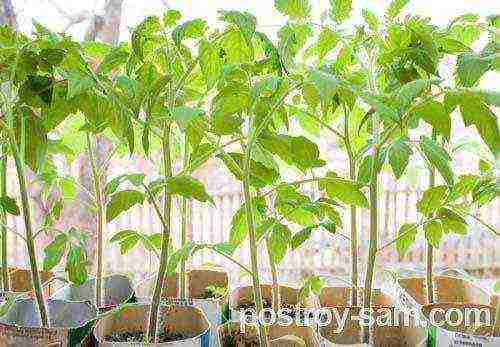
In order for your work to be crowned with success, you must follow some rules for growing vegetables on the windowsill:
- Choosing the right seed is key. Self-pollinated and early ripening varieties, undersized or bush plants are suitable for growing in an apartment. Modern breeders have developed special varieties intended for growing in an apartment. The seed bag will say “suitable for growing in an apartment”.
- For sown seeds to grow lush and healthy fruiting plants, they need to provide optimal conditions for growth and development. This is a temperature regime and sufficient lighting. Vegetable beds will thrive on south or southeast windows. In winter, cloudy, short days, additional illumination with fluorescent lamps is necessary.
- Watering plants should be done with settled water at room temperature, which is 20-25 degrees.
- Plants need regular feeding, especially during fruit ripening. To do this, you can use a complex universal fertilizer, which can be bought in a specialized store, or special growth concentrates.
- Plants on the windowsill must be turned 180 degrees to the light every day so that the leaves receive the required amount of light evenly and do not bend on their own towards the window.
Artificial lighting of the garden on the windowsill

On cloudy winter days, the garden on the windowsill especially needs light, because light is the main component of such an important process for plants as photosynthesis, without which their normal development is simply impossible. Therefore, in winter, in order to grow lush healthy plants, artificial supplementary lighting is necessary.
You can illuminate the beds using fluorescent lamps of daylight or white light. These lamps do not emit heat and produce light similar to sunlight. Therefore, they are an ideal source of additional lighting. Phytolamps, specially designed for indoor supplementary lighting of plants in winter, appeared in specialized stores.
In order to properly organize the supplementary lighting of the beds, fluorescent lamps are suspended above the plants at a height of 10 cm (for light-loving plants) or 40-50 cm (for shade-tolerant plants), at the rate of 200-300 W per 1 square meter of windowsill.
To correctly calculate the required amount of light, you need to multiply 200-300 W by the area of the windowsill, and thus select the lamps of the required power.
Fluorescent lamps can be connected to a timer. Then they will turn on and off by themselves at the time period you specify, when the plants most need additional lighting.
How to grow cucumbers on a windowsill?
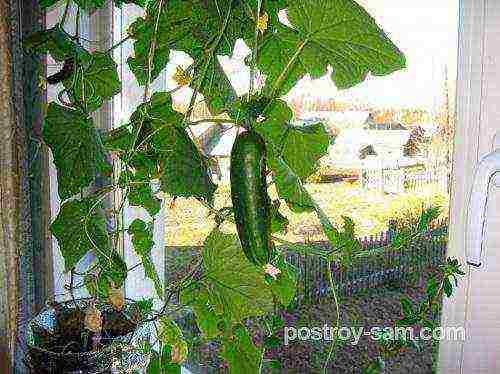
For successful cultivation of this crop on the windowsill, you must choose the right seeds. For indoor conditions, self-pollinated varieties of cucumbers for greenhouses are suitable. It is best to grow bush varieties of this plant on the window. If you decide to grow bee-pollinated varieties, then you will have to manually pollinate them.
Cucumber is very demanding for heat and light, so it should be placed on warm south or south-east windows. Cucumber reacts very negatively to drafts. To provide this plant with sufficient warmth, the windows must be insulated, and the window must be closed with polyethylene to avoid cold air entering the plant when ventilating. The cucumber, like other vegetables on the windowsill, must be supplemented with fluorescent lamps in winter.
Before sowing in the ground, the seeds can be pre-germinated in order for them to grow faster. To do this, they need to be placed between layers of gauze or toilet paper and soaked in warm water. Keep the seeds in a warm place at a temperature of 28-30 degrees for 2-3 days, not allowing the paper to dry out. When seedlings 2-3 mm in size appear, the seeds are ready for sowing.
Sprouted seeds can be sown in seedling cups, or immediately placed in a permanent place in a prepared container. It should be borne in mind that for normal development, the plant needs a volume of land of at least 3 liters.
After sowing the seeds, the containers are covered with a transparent film and placed in a warm place until sprouts appear. Then the film is removed and the seedlings are moved to the south window. On cloudy winter days, the seedlings are provided with additional lighting. If the seedlings are grown in small cups, then after the appearance of 2-3 true leaves, they must be transplanted to a permanent place.

When 5-6 leaves grow on the plant, and the mustache begins to grow, it is necessary to attach a peg or a stretched twine to it, along which the plant will curl. Above 11-12 leaves, the cucumber will need to be pinched, otherwise it will not bear fruit. The emerging side shoots must be removed.
If bee-pollinated cucumbers grow on your windowsill, the process of pollination falls on your shoulders. To do this, a bright yellow male inflorescence is plucked from the plant (female flowers do not have a bright color) and touch the female flowers with it. Pollination can also be done with a cotton swab wound on a match, transferring pollen from one flower to another on the cotton swab. Pollination is best done in the morning. Subject to optimal growing conditions, 12-15 medium-sized fruits can be harvested in one plant.
Growing tomatoes on a windowsill

Just like a cucumber, a tomato is very fond of warmth and light, so it should be placed on the south or southeast windows. A tomato is not afraid of drafts, unlike a cucumber, so the air temperature can be controlled by airing the room. For the successful growth of tomatoes, an air temperature of 28 degrees during the day and 15 degrees at night is required.
For growing at home, you need to select undersized, early ripening and small-fruited varieties of tomatoes.
Tomatoes can be grown in seedlings, or directly sow the seeds to a permanent place in a large prepared container. For the normal development of the plant, the required volume of dishes must be at least 3.5-4 liters.
Seeds are sown in the ground, covered with a transparent film and placed in a warm place for germination. When shoots appear, the film must be removed and the seedlings must be placed on the windowsill. In winter, the plants must be supplemented.
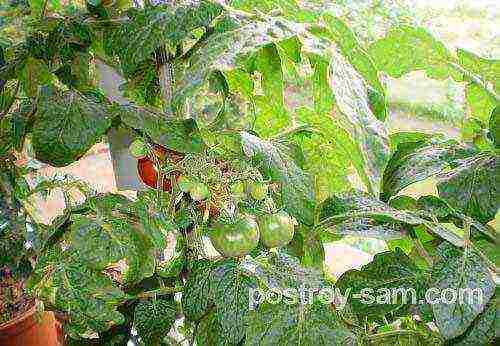
Tomatoes are susceptible to fungal disease, which is a major problem in their cultivation. This is due to excess moisture in the soil and air. Therefore, watering the plants must be done with caution, not to allow waterlogging. Watering should be done twice a week with lukewarm water. If the room is too damp, then in order to avoid fungal damage, the tomatoes should be sprayed with the Bordeaux mixture, which is prepared as follows: 10 grams of copper sulfate are dissolved in 1 liter of water. Separately, 20 grams of slaked lime is dissolved in 100 grams of water. The lime mixture is poured into a solution of copper sulfate in a thin stream and stirred. Plants are sprayed with this mixture. You can save the Bordeaux mixture for a day.
For better pollination of tomatoes, plants during flowering can be lightly tapped on the peduncles several times a week to pollinate them. When the main part of the fruit begins to form, the top of the plant must be cut off. All blooming brushes are also removed. If this is not done, the plant will not have enough strength to ripen full-fledged fruits.
Technology for growing pepper in an apartment

Pepper is the easiest plant to grow at home. This is especially true for bitter varieties. On the windowsill, you can grow any kind of pepper at your discretion. The main thing is not to put a bitter and sweet variety next to it, in order to avoid cross-pollination, as a result of which the sweet pepper can acquire a bitter taste.
If you have your own vegetable garden in which vegetables grow in summer, you can dig up pepper bushes, transplant them into pots and put them on a windowsill for the winter. Pepper is a perennial plant, so it can grow in a pot for several years. For normal growth and development, pepper needs a pot volume of 3.5-4 liters, and for bitter varieties - 1.5-2 liters.
You can grow pepper on a windowsill from seeds. To do this, they are pre-soaked in warm, putting them between layers of gauze or paper napkin for 3-4 days. As they dry, they need to be moistened.
Sprouted seeds are sown in the prepared soil in a permanent place, the crops are covered with a transparent film and placed in a warm place until shoots appear. Seedlings appear in about 2-2.5 weeks. When shoots appear, the film must be removed, and the seedlings must be rearranged on a warm windowsill. When 5-6 true leaves grow on the plant, they are thinned out, leaving 1 seedling for 3-3.5 liters of soil volume. Excess seedlings can be transplanted.

Pepper care consists in regular watering with settled warm water, loosening and feeding. Pepper really does not like temperature changes and drafts, therefore, for the successful cultivation of this culture, the pepper must be provided with optimal conditions. It is advisable to feed it 2 times a month with a complex mineral fertilizer, which can be bought in a specialized store. In winter, the plants need to be supplemented. Almost all varieties of pepper are incapable of self-pollination, therefore, they need artificial pollination. During flowering, branches with flowers need to be shaken, or, using a match and cotton swab, transfer pollen from flower to flower, performing the function of a bee.
By organizing a vegetable garden on the windowsill, you will not only be provided with fresh vitamins all year round, but also give originality to the interior of your apartment, bringing into it a special touch of unity with nature.


